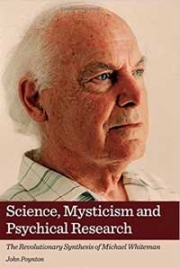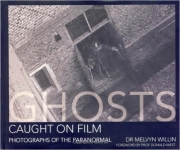
From the publisher’s website: What happens after we die? Spirits speaking through mediums know. They want us to know. This book unveils their world.
Stafford Betty earned his PhD in theology from Fordham University, teaches religious studies at California State University in Bakersfield, and has gradually evolved into a world expert on afterlife studies. Originally a specialist in Asian religious thought and the philosophy of religion, he branched out into paranormal research when he found the big questions about life's meaning unanswered in the safe, tidy world of academic orthodoxy. "Paranormal studies is the next frontier for philosophers and scientists to venture into," Professor Betty says. He has published five books of fiction, his latest "The Imprisoned Splendor" (November 2011), which has as its setting the afterlife. When not writing and teaching, he tries to guide his children, enjoys watching BBC drama with his wife in the evenings, and golfs once a week. He lives in Bakersfield, California.
In this short book, Stafford Betty, Professor of Religion at California State University at Bakersfield looks at what he regards as “some of the most interesting literature on the planet”, the communications from the ‘other side’ that in his view are “the best of the genre... the richest, most revelatory, most fertile I have come across in a quarter of a century of researching this sometimes dubious material”.
The core of the book is a chapter each on what we learn from the spirit/medium ‘collaborations’ between (in chronological order): 1. Imperator (and his group) and Stainton Moses (in Spirit Teachings1883 and More Spirit Teachings 1892); 2. Leslie Stringfellow and his mother (in The Afterlife of Leslie Stringfellow 2005); 3. Judge David Hatch and Elsa Barker (in Letters from the Afterlife 1995); 4. Frederick Myers and Geraldine Cummins (in The Road to Immortality 1995); 5.Monsignor Robert Hugh Benson and Anthony Borgia (in Life in the World Unseen 1934); 6. Frances Banks and Helen Greaves (in Testimony of Light 1977); and 7. Alvin D. Mattson and Margaret Flavell (in Witness from Beyond 1975 and Evidence from Beyond 1999).
Each of these chapters says a little about the ‘communicator’ and medium involved, the method of communication (e.g. through automatic writing, the use of a planchette or clairaudient dictation) and Betty’s evidential reasons for believing the source to be the spirit named rather than the medium’s subconscious, before giving the gist of the communication in the form of spirit quotes (in bold so they stand out) linked by Betty’s’ questions, summaries and comments.
In the Introduction, Betty outlines his reasons for both believing and doubting what comes through in these accounts and why on balance “I am very nearly convinced that most of what you read here really came from the other side and came through accurately”. He also argues that it is a good thing both for individuals and for society at large that we know what we can look forward to (or not in some individual cases!)
In the Conclusion, he summarizes “what we have learned from our seven spirit sources” in 43 succinct numbered points plus a longer review of what was said about reincarnation. In an Afterword, he responds to Karen Armstrong’s saying that the question of an afterlife is a ‘red herring’ and distraction from important questions and experiences in this life.
The book is very well organised, clearly written and fully indexed. If we take on trust that he has fairly quoted from and summarised his published sources, then it provides a very easy way for anyone to engage with a representative selection of such 19th and 20th century UK and US material without having to go to the sources themselves. (I just saw that the cheapest used copy of the Leslie Stringfellow book on Amazon costs £75!).
But what should we make of the picture of the afterlife (if there is one) presented here? It is one thing to be persuaded by the evidence and arguments for the possibility of some form of survival of personal consciousness (despite the most powerful philosophical and scientific arguments against) but quite another to picture with any confidence at all what such life after death might actually be like. In Betty’s accounts (as in others), some of the broad structural features of the spirit world and the generalisations about links between the earth world and the spirit world seem to me at least plausible, if not convincing. It is the specifics that are impossible for me – as for so many others well-disposed in principle to the idea of an afterlife – to take at face value, as Betty for the most part seems to do.
Moreover, not all readers – even those who have lived exemplary lives or are moved by the book to do so from now on – will find the prospect of the afterlife presented here equally appealing. The ways in which the world that awaits us (or most of us) is a ‘world of exquisite natural beauty... a joyful, fascinating place, full of challenges for those who desire to grow” sound all very well in themselves – but not so good for someone whose main pleasures in this life are motor cars (there is no traffic in the afterlife) or playing or watching competitive sport (there would be no point to it as “thought controls movement and the usual effects of gravity can be annulled at will”). It is suggested that “there is a superabundant supply of vastly more entertaining things to be seen and done here’ – but the examples given (such as going to historical plays and knitting) may seem disappointing.
What we would like to be the case in any afterlife is of course not relevant to the question of what is the case –at any rate if there is any answer to the question ‘What is it like to be in the spirit world?’ that is objectively independent of the spirit answering at a particular time and place in that world. But Betty’s reports suggest that the world his spirit sources describe is largely if not wholly, a subjective world – that the music, gardens, landscapes and buildings that surround them and that they find so exquisitely beautiful are not objective features of the spirit world they find themselves in (the same for everyone) but personal to them individually. If this is the case then the music and gardens etc could be just what one wants them to be. If not, then do all spirits suddenly some to share the same taste in music and gardens etc? And what are we to make, to give just one of many puzzling examples, of Leslie Stringfellow’s report of Mozart giving a public lecture on music, more than a hundred years after he had died?
If we are more inclined to accept some parts of what is said about the afterlife than others, on what basis can we be confident that we are not just cherry-picking those part that most appeal to us? Betty attaches weight to descriptions in the various reports that tie in with or reinforce each other – but if the mediums in the later cases were picking up ideas from other than the ostensible communicators, then these would be the most obvious candidates.
After reading The Afterlife Unveiled and drafting the bulk of this review, I checked Jeffrey Mishlove’s excellent interview with Stafford Betty in his ‘New Thinking Allowed’ series on You Tube. Here Betty gives a very clear summary of the main ideas in the book which, as Mishlove says, ought to be of interest to all of us, whatever we may think of them.







